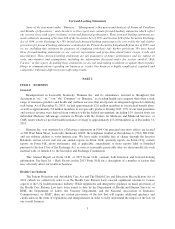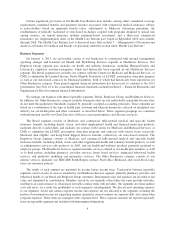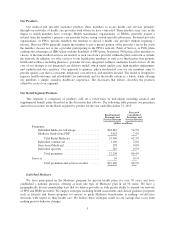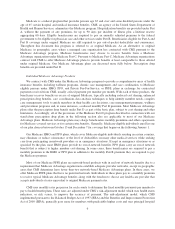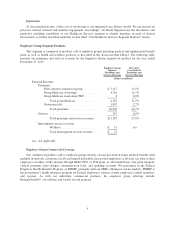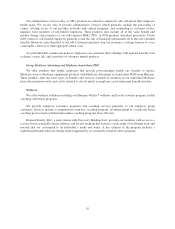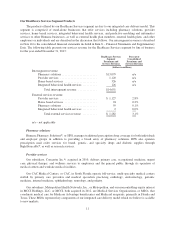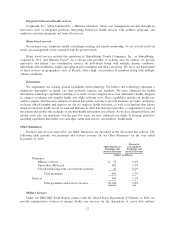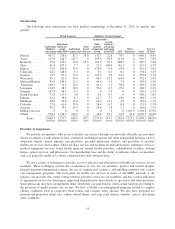Humana 2013 Annual Report Download - page 14
Download and view the complete annual report
Please find page 14 of the 2013 Humana annual report below. You can navigate through the pages in the report by either clicking on the pages listed below, or by using the keyword search tool below to find specific information within the annual report.Certain significant provisions of the Health Care Reform Law include, among others, mandated coverage
requirements, mandated benefits and guarantee issuance associated with commercial medical insurance, rebates
to policyholders based on minimum benefit ratios, adjustments to Medicare Advantage premiums, the
establishment of federally facilitated or state-based exchanges coupled with programs designed to spread risk
among insurers, an annual insurance industry premium-based assessment, and a three-year commercial
reinsurance fee. Implementation dates of the Health Care Reform Law began in September 2010 and continue
through 2018. The Health Care Reform Law is discussed more fully in Item 7. – Management’s Discussion and
Analysis of Financial Condition and Results of Operations under the section titled “Health Care Reform.”
Business Segments
On January 1, 2013, we reclassified certain of our businesses to correspond with internal management
reporting changes and renamed our Health and Well-Being Services segment as Healthcare Services. Our
Employer Group segment now includes our health and wellness businesses, including HumanaVitality and
Lifesynch’s employee assistance programs, which had historically been reported in our Healthcare Services
segment. The Retail segment now includes our contract with the Centers for Medicare and Medicaid Services, or
CMS, to administer the Limited Income Newly Eligible Transition, or LI-NET, prescription drug plan program
as well as our state-based contracts for Medicaid members, both of which had historically been reported in our
Other Businesses category. Prior period segment financial information has been recast to conform to the 2013
presentation. See Note 16 to the consolidated financial statements included in Item 8. – Financial Statements and
Supplementary Data for segment financial information.
We manage our business with three reportable segments: Retail, Employer Group, and Healthcare Services.
In addition, the Other Businesses category includes businesses that are not individually reportable because they
do not meet the quantitative thresholds required by generally accepted accounting principles. These segments are
based on a combination of the type of health plan customer and adjacent businesses centered on integrated care
delivery for our health plans and other customers, as described below. These segment groupings are consistent
with information used by our Chief Executive Officer to assess performance and allocate resources.
The Retail segment consists of Medicare and commercial fully-insured medical and specialty health
insurance benefits, including dental, vision, and other supplemental health and financial protection products,
marketed directly to individuals, and includes our contract with Centers for Medicare and Medicaid Services, or
CMS, to administer the LI-NET prescription drug plan program, and contracts with various states to provide
Medicaid, dual eligible, and Long-Term Support Services benefits, collectively our state-based contracts. The
Employer Group segment consists of Medicare and commercial fully-insured medical and specialty health
insurance benefits, including dental, vision, and other supplemental health and voluntary benefit products, as well
as administrative services only products, or ASO, and our health and wellness products primarily marketed to
employer groups. The Healthcare Services segment includes services offered to our health plan members as well
as to third parties, including pharmacy, provider services, home based services, integrated behavioral health
services, and predictive modeling and informatics services. The Other Businesses category consists of our
military services, primarily our TRICARE South Region contract, Puerto Rico Medicaid, and closed-block long-
term care insurance policies.
The results of each segment are measured by income before income taxes. Transactions between reportable
segments consist of sales of services rendered by our Healthcare Services segment, primarily pharmacy, provider, and
behavioral health, to our Retail and Employer Group customers. Intersegment sales and expenses are recorded at fair
value and eliminated in consolidation. Members served by our segments often utilize the same provider networks,
enabling us in some instances to obtain more favorable contract terms with providers. Our segments also share indirect
costs and assets. As a result, the profitability of each segment is interdependent. We allocate most operating expenses
to our segments. Assets and certain corporate income and expenses are not allocated to the segments, including the
portion of investment income not supporting segment operations, interest expense on corporate debt, and certain other
corporate expenses. These items are managed at the corporate level. These corporate amounts are reported separately
from our reportable segments and included with intersegment eliminations.
4











